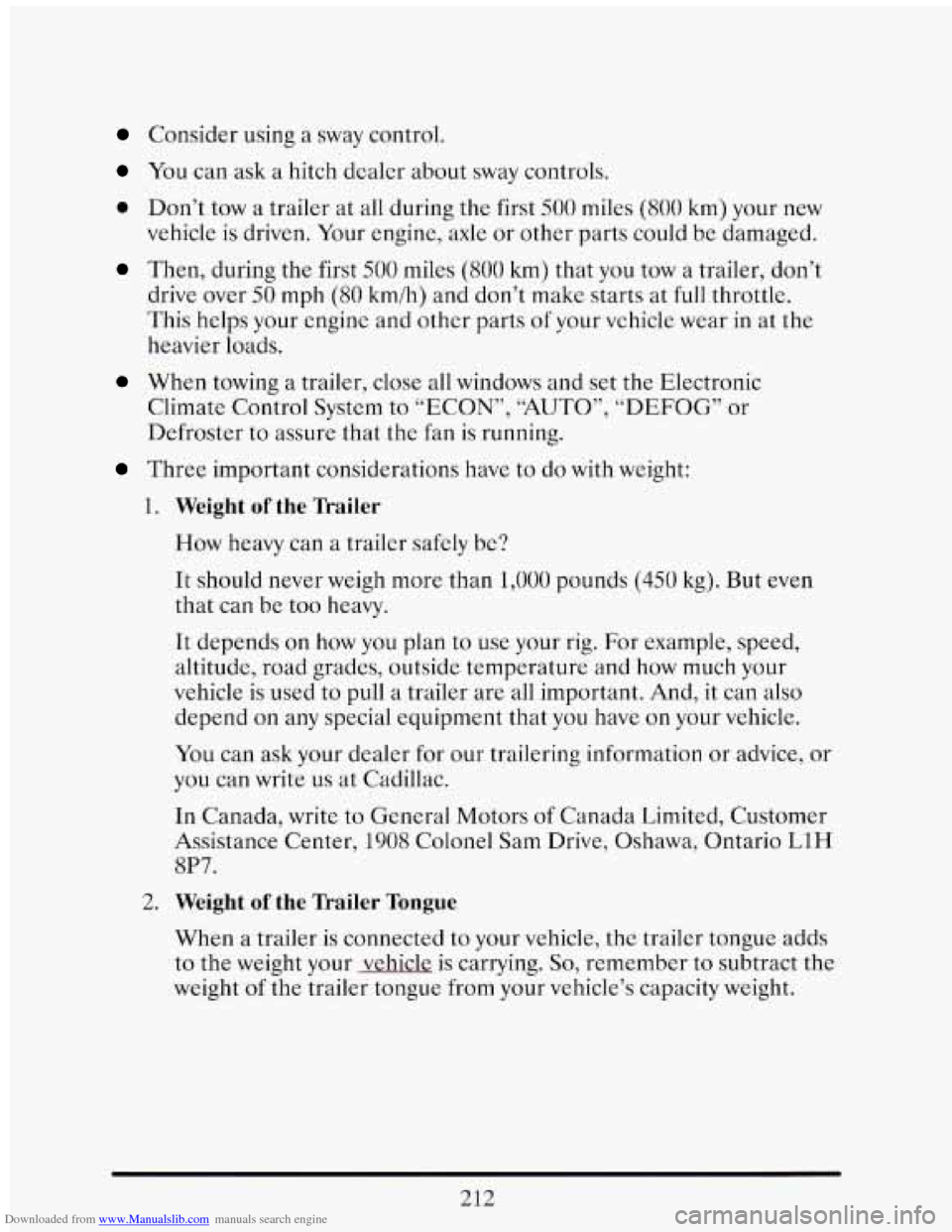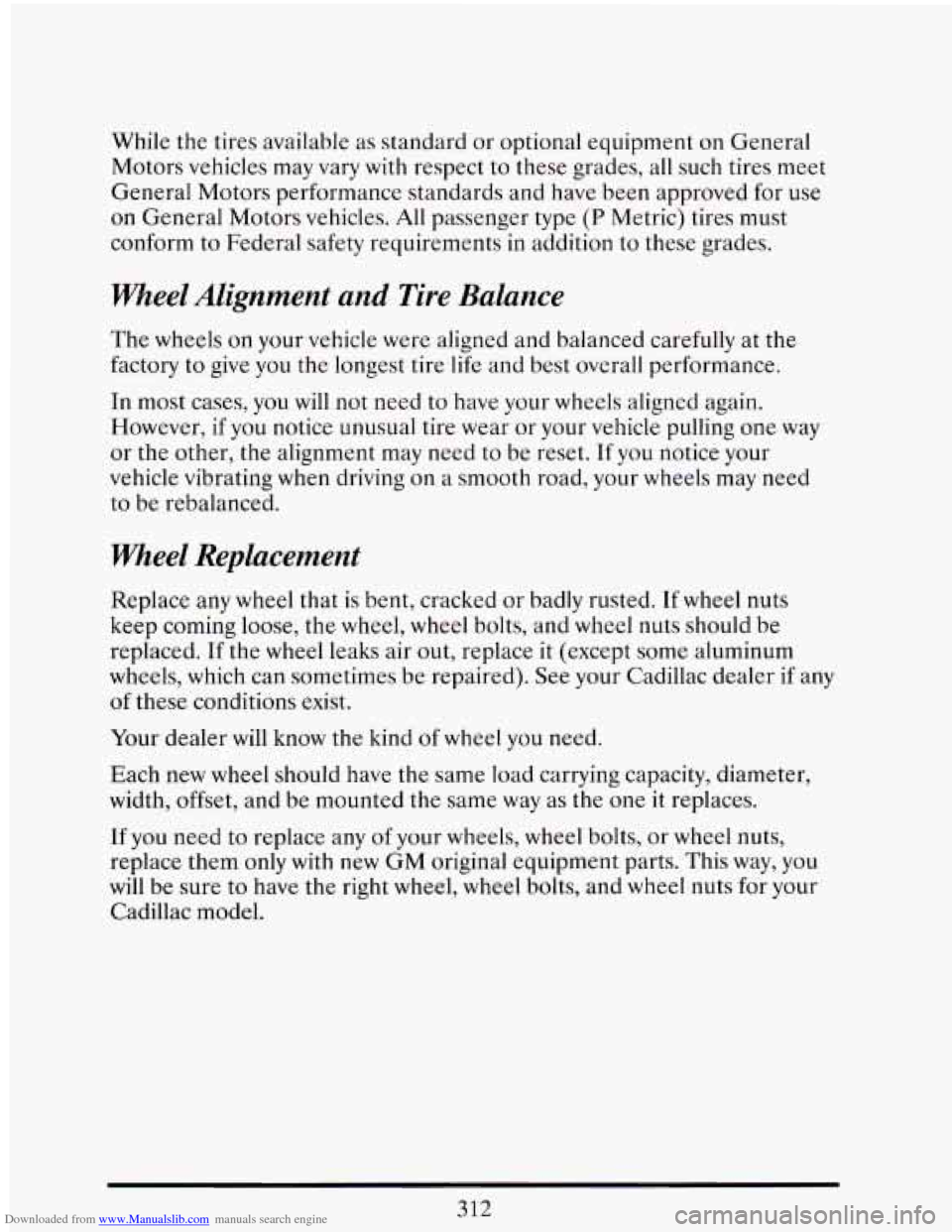Page 144 of 398

Downloaded from www.Manualslib.com manuals search engine Fuel Gage
Your fuel gage shows about how much fuel is in your tank. It works only
when the ignition is
in the “RUN” position.
Digital Gage
If the fuel level is within approximately one gallon (3.9 liters) of being full
the letter “F” is shown.
If the fuel level
is between 1 and 2 gallons (3.9 and 7.6 liters) from being
empty the letter
“E” is shown. If the fuel supply gets down to
approximatcly 1 gallon (3.9 liter) the ”E” will flash, and the “ FUEL
LEVEL VERY LOW” message will appear
in the Driver Information
Center (DIC). (On the analog
fuel gage, the “FUEL LEVEL VERY
LOW’’ message will
also appear.)
Here are a few concerns some owners have had about the fucl gage. All
these situations are normal and indicate nothing wrong with the fuel
gage.
0 At the gas station, the gas pump shuts off before the gage reads “F”.
It takes more (or less) gas to fill up than the gage said. For example,
the gage said “8 Gallons”? but it took morc -- or less -- than the tank’s
remaining capacity
to fill it.
The gage changes when you turn (or stop, or speed up).
Page 226 of 398

Downloaded from www.Manualslib.com manuals search engine Consider using a sway control.
You can ask a hitch dealer about sway controls.
0 Don’t tow a trailer at all during the first 500 miles (800 km) your new
vehicle is driven. Your engine, axle or other parts could be damaged.
Then, during the first 500 miles (800 km) that you tow a trailer, don’t
drive over 50 mph (80 kmih) and don’t make starts at full throttle.
This helps your engine and other parts
of your vehicle wear in at the
heavier loads.
When towing a trailer, close all windows and set the Electronic
Climate Control System
to “ECON”, “AUTO”, “DEFOG” or
Defroster to assure that the fan is running.
Three important considerations have to do with weight:
1. Weight of the nailer
How heavy can a trailer safely be?
It should never weigh more than 1,000 pounds (450 kg). But even
that can be too heavy.
It depends on how you plan to use your rig. For example, speed,
altitude, road grades, outside temperature and how much your
vehicle
is used to pull a trailer are all important. And, it can also
depend on any special equipment that you have on your vehicle.
You can ask your dealer for our trailering information or advice, or
you can write
us at Cadillac.
In Canada, write to General Motors of Canada Limited, Customer
Assistance Center,
1908 Colonel Sam Drive, Oshawa, Ontario L1H
8P7.
2. Weight of the Trailer Tongue
When a trailer is connected to your vehicle, the trailer tongue adds
to the weight your vehicle is carrying.
So, remember to subtract the
weight of the trailer tongue from your vehicle’s capacity weight.
212
Page 283 of 398
Downloaded from www.Manualslib.com manuals search engine 4.6 Liter (Northstar)
.. - ... . . -
- . .. , -I .
When to Add Oil: If the oil is at or below the ADD line, then you’ll need
to add some
oil. But you must use the right kind. This section explains
what kind
of oil to use. For crankcase capacity, see “Capacities and
Specifications”
in the Index.
269
Page 317 of 398
Downloaded from www.Manualslib.com manuals search engine Once you have
replaced
the air
cleaner filter, reverse the steps to reassemble and install back into
your vehicle.
LOADING YOUR VEHICLE
OCCUPANTS VEHICLE
CAP. WT.
TIRE-LOADING
INFORMATION
FRT. CTR.
RR. TOTAL LBS. KG
MAX. LOADING
& GVWR SAME AS VEHICLE
CAPACITY WEIGHT XXX COLD TIRE
TIRE
SIZE SPEED PRESSURE
RTG
PS VKPa
FRT.
RR.
SPA.
IF TIRES ARE HOT. ADD 4PSV28KPa SEE
OWNER'S MANUAL FOR ADDITIONAL
GEN GME \INFORMATION
Two labels on your vehiclc show how much weight it may properly carry.
The Tire-Loading Information label found on the driver's door tells you
the proper size, speed rating and recommended inflation pressures for
the tires on your vehicle.
It also gives you important information about
the number of people that can be in your vehicle and thc total weight that
303
Page 318 of 398

Downloaded from www.Manualslib.com manuals search engine you can carry. This weight is called the Vehicle Capacity Weight and
includes the weight
of all occupants, cargo, and all nonfactory-installed
options.
MFD BY GENERAL MOTORS CORP
DATE GVWR GAWR FRT GAWR
RR
THIS VEHICLE CONFORMS TO ALL APPLI-
CABLE
U.S. FEDERAL MOTOR VEHICLE
TION STANDARDS IN EFFECT ON THE
DATE OF MANUFACTURE SHOWN ABOVE.
SAFETY, BUMPER,
AND THEFT PREVEN-
GEN GME I
The other label is the Certification label, found on the rear edge of the
driver’s door. It tells you the gross weight capacity of your vehicle, called
the GVWR
(Gross Vehicle Weight Rating). The GVWR includes the
weight of the vehicle, all occupants, fuel and cargo. Never exceed the
GVWR
for your vehicle, or the Gross Axle Weight Rating (GAWR) for
either the front or rear axle.
And, if you do have a heavy load, you should spread it out. Don’t carry
more than
185 lbs. (84 kg) in your trunk.
A CAUTION:
Do not load your vehicle any heavier than the GVVVR or the
maximum front and rear GAWRs. If
you do, parts on your
vehicle can break, or it can change the way your vehicle handles.
These could cause
you to lose control. Also, overloading can
shorten the life of your vehicle.
304
Page 326 of 398

Downloaded from www.Manualslib.com manuals search engine While the tires available as standard or optional equipment on General
Motors vehicles may vary
with respect to these grades, all such tires meet
General Motors performance standards and have been approved for use
on General Motors vehicles. All passenger type
(P Metric) tires must
conform to Federal safety requirements in addition
to these grades.
meel Alignment and Tire Balance
The wheels on your vehicle were aligned and balanced carefully at the
factory to give
you the longest tire life and best overall performance.
In most cases, you will not need to have your wheels aligned again.
However,
if you notice unusual tire wear or your vehicle pulling one way
or the other,
the alignment may need to be reset. If you notice your
vehicle vibrating
when driving on a smooth road, your wheels may need
to be rebalanced.
Wheel Replacement
Replace any wheel that is bent, cracked or badly rusted. If wheel nuts
keep coming loose, the wheel, wheel bolts, and wheel nuts should be
replaced. If the
wheel leaks air out, replace it (except some aluminum
wheels, which can sometimes be repaired). See your Cadillac dealer if any
of these conditions exist.
Your dealer
will know the kind of wheel you need.
Each new
wheel should have the same load carrying capacity, diameter,
width, offset, and be mounted the same way as the one
it replaces.
If you need to replace any of your wheels, wheel bolts, or wheel nuts,
replace them only
with new GM original equipment parts. This way, you
will be sure to have the right wheel, wheel bolts, and wheel nuts for your
Cadillac model.
312